

| Dragon | - | Magic Items | - | Dragon 117 |
| Horned Mask | Veil Mask | Winged Mask | Skull Mask | Mask of Magic |
| Fanged Mask | Mirror Mask | - | Mask of Silence | Mask of Winds |
From the now-ruined city of Myth Dran-
nor, Elminster the Sage told me, came
much of the magic of the Realms. From its
lore, Elminster revealed mighty spells and
items of power ? swords and shields,
harps and rings, and more. But, upon a
night not long ago, Elminster and I sat in
my study watching the cats asleep at our
feet, and Elminster stopped in his ram-
blings of kings long dead and battles long
fought, and said, ?I would tell you of some
gentler magic.?
I voiced my eagerness, and he nodded in
approval. ?Well-loved among the mages of
the City of Song was the Lady Shandalee.
Of her I speak,? he began, and wove a tale
that whole night through (save for a glass
of wine here and there) until dawn, telling
of the deeds and grace of the Lady
Shandalee.
I?ve set down no part of that tale here,
but I pass on details of Shandalee?s only
legacy ? her marvelous masks, items of
magical power whose means of fashioning
are unknown in the Realms, having passed
away with the Lady of the Stars. Many
such masks are found in the Realms, for
they were often buried on corpses of good
and noble persons. The masks are usable
by all creatures able to wear them about
the eyes, regardless of class or race. They
are of nine sorts, being distinguished one
from another only by shape of outline and
ornamentation. All are of some unknown,
silky-gray fabric that cannot be physically
harmed; weapons pass through such
masks as though they do not exist.
The masks cannot be burned, stiffened,
or adversely affected by freezing cold,
deep water, acid, or claws, but they are
vulnerable to electrical energies (20 +
1d12 hp electrical damage must be suf-
fered by any particular mask before it is
destroyed). A mask?s powers may be ne-
gated for 1-6 rounds by the casting of a
dispel magic (against 18th-level magic) or
for 2-12 rounds by a wand of negation,
but are never altered in power by other
magics or by physical circumstances. A
mask never loses only part of its powers;
these magical facial coverings work fully
or not at all.
Placing such a mask on the face causes
the mask to shift in size, to cover the face
from nostrils to brow and from ear to ear,
with eyes uncovered. The mask clings
without need of ties or adjustment, until
pulled away; it readily peels off at the
touch of bare flesh grasping it (against AC
10), regardless of the wearer?s wishes.
Such masks radiate a faint dweomer if a
detect magic is cast. DMs must determine
the monetary and experience point value
of such items in accordance with the situa-
tions of their own campaigns. Shandalee?s
masks are as follows.
Horned mask
So-called because it sports two horns
curving up from its upper edges, this mask
allows the wearer augmented vision: 9?
infravision, 7? ultravision, the ability to
clearly see ethereal creatures, shadows
(q.v., Monster Manual I) and all creatures
which can hide in shadows (including
thieves), and the ability to see through
flames, mist, fog, smoke, and other opaque
vapors or conflagrations (these obstruc-
tions appear only as faint outlines or dis-
turbances). The wearer is also protected
against blindness, however caused, while
wearing the mask, and cannot be dazzled,
charmed, hypnotized, or stunned by light
displays, even if these are very intense or
magical. The mask-wearer cannot confer
any of the mask?s powers to anyone else,
and the mask does not enable its wearer
to detect illusions or disguises, nor to see
invisible creatures. The wearer of the
mask can track as a 1st-level ranger (un-
less such tracking abilities are already
possessed, in which case the mask in-
creases them by one level of ranger-
tracking ability while worn).

Veil mask
Named for both its appearance and
function, this mask completely covers all
of the wearer?s face in an impassive ex-
panse; only the wearer?s eyes can commu-
nicate any expression. While worn, it
completely hides and protects the wearer
from any mind-reading or mind-
influencing spells (charm, sleep,
ESP, etc.)
and any divination or similar spells involv-
ing the wearer (including detect lie,
alignment-aura reading, and the like). It
also causes offensive attacks of these sorts
? i.e., psionics and enchantment/charm
spells ? to be reflected back upon the
caster. If reflection is impossible due to the
nature of the attack, the spell is merely
negated. The mask does not confer actual
or psionic invisibility upon the wearer.

Winged mask

The edges of this mask are cut so as to
resemble rows of feathers. The wearer
can fly at will, without
tiring, as often as
desired and for as long as is desired, but
may not carry any other living creature
while doing so. Nonliving material (such as
the wearer?s clothing, not including the
weight of the mask itself) up to a weight
limit of 500 gp may also be carried; this is
not much, and any material in excess of
the weight limit negates the mask?s flying
abilities.
While flying, the wearer of a winged
mask has a maneuverability class rating of
A, can remain upright if desired, and has
great stability, allowing the user to cast
spells, write, and perform other intricate
tasks. Movement is at any speed up to 26?/
round as desired, and the wearer can
hover or fly backwards without turning.
While the mask?s powers of flight are
activated, the wearer glows with a soft,
white faerie fire radiance, regardless of
the wearer?s wishes. If another living
creature touches, grapples with, or is
carried by the wearer of a winged mask
while the latter is flying, the wearer falls;
the mask confers the protection of a
feather fall spell on the mask wearer, but
not upon the other contacting creature(s).
Skull mask
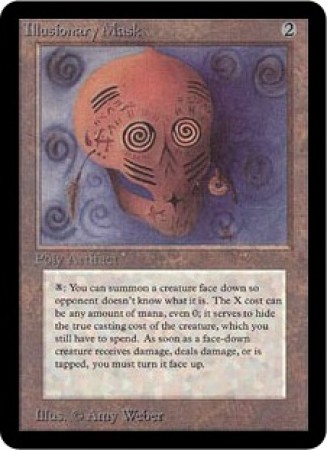
This mask always gives the wearer's face
a skull-like appearance, with dark sockets
about the eyes and nose, and bared teeth.
While worn, it confers immunity to fear
of
any sort and to the life-level draining,
strength draining, or aging attacks of all
undead or other creatures. Diseases and
paralysis of all sorts are also prevented, as
is chilling damage from undead attacks ?
but the mask gives the wearer no control
or influence over undead, and no protec-
tion against the physical attacks of undead
(or any poisonous aspects of such attacks).
Undead are drawn towards the mask
wearer, attacking him or her in preference
to other creatures. The wearer of this
mask can instantly recognize any beings
seen as dead, living (including beings petri-
fied or in suspended animation), undead,
or never living (i.e., a stone statue).
Mask of magic
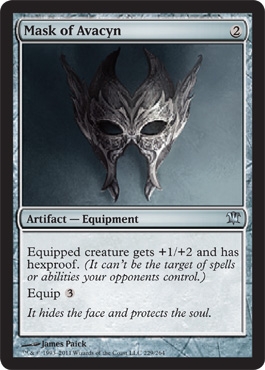
This mask always appears perfectly
circular. The wearer can see magical
dweomers and auras (including those of
surfaces or areas bearing symbols,
glyphs,
inscriptions, and the like), although such
things cannot be read or closely examined.
Only location, outline, and relative inten-
sity of magical power can be discerned.
This magical sight is continuous and invol-
untary while the mask is worn.
Fanged mask
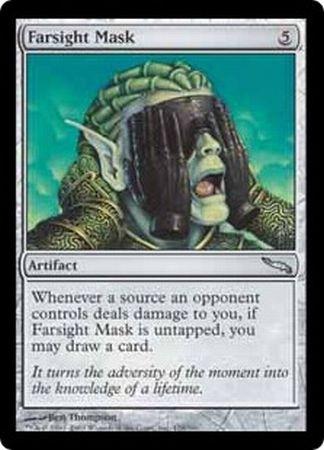
The bottom of this mask is cut in the
shape of downward-pointing fangs, like
those of some great cat. When worn, the
wearer can bite in combat for 1-4 hp dam-
age. If the wearer?s bite already does ap-
preciable damage ? e.g., the wearer is a
creature like a norker ? 1d4 hp
damage is
added to existing bite damage. The bite
affects even targets that are astral, ethe-
real, or from the Lower Planes (such as
those that can normally be hit only by
magical weapons). The bite stuns a victim
for the round following its striking home
if a save vs. spells is failed, but it does not
augment any blood-draining abilities the
wearer may already possess. Such attacks
must be delivered normally; the wearer
must come into close contact with oppo-
nents and is not protected from their
attacks or abilities by the mask.
Mirror mask
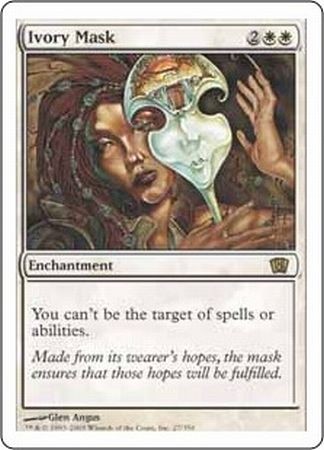
This mask appears as a circle with dark
lines radiating outwards from a central
focus around the wearer?s nose. Anyone
gazing at the wearer does not see the
mask, instead seeing the viewer?s own
head perfectly depicted. Creatures not
looking directly at the mask see the mask
instead. The mask reflects all gaze attacks
back upon the gazer, and the wearer
can meet the gaze of any being without
being affected by awe, fear,
horror, hyp-
notic gaze effects, charms, suggestions,
etc.
Mask of silence
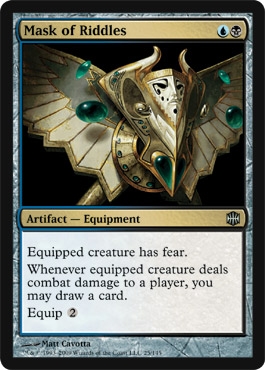
This mask covers the area around the
eyes of the wearer, and has a trailing veil
that flows down to cover the wearer?s
mouth, moving always to cover the lips
(the mask must be removed to eat or
drink). At will, the wearer can magically
silence one creature within 5? range per
round. The victim gets a save vs. breath
weapon to avoid these effects. Such si-
lence lasts one round and is usable every
fourth round. If a target successfully saves
against a silence attempt, the masks
power has still been used, and the wearer
cannot attempt to affect another target
until three intervening rounds have
elapsed. If successful, such silence pre-
vents all noise from the victim, not just
vocal sounds, and can be used by the
mask-wearer on himself (although the
mask-wearer gets a saving throw to avoid
the masks effects, too, regardless of his
own wishes). This silence prevents
spellcasting, shouted warnings, death-
cries, and the like.
Mask of winds
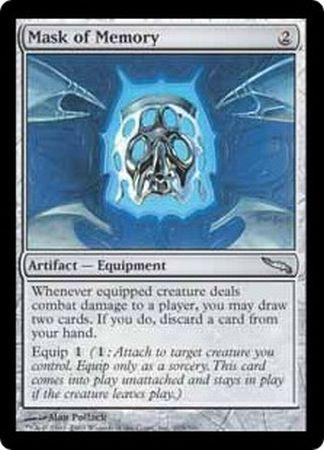
Appearing as a vertical bellows-shape,
point downwards, this mask allows the
wearer to influence the movements of
gases and vapors within a 6?-radius
sphere at will. Thus, the wearer can ne-
gate or turn aside gale-force winds (includ-
ing magical gusts of wind),
turn back
convection currents, smoke, gaseous-form
creatures, poison gas, and even scent-
carrying breezes. The wearer can rob
fires of fresh oxygen by stilling air move-
ments (large fires, such as those of burn-
ing structures, are not easily extinguished
solely by use of such a mask), but he can-
not cause a vacuum nor asphyxiate oppo-
nents. The wearer can create gusts of
wind or wind walls, as in the spells, once
each every six rounds. Heat or cold effects
from air movements (for example, hypo-
thermia from arctic winds) can be less-
ened or negated.
